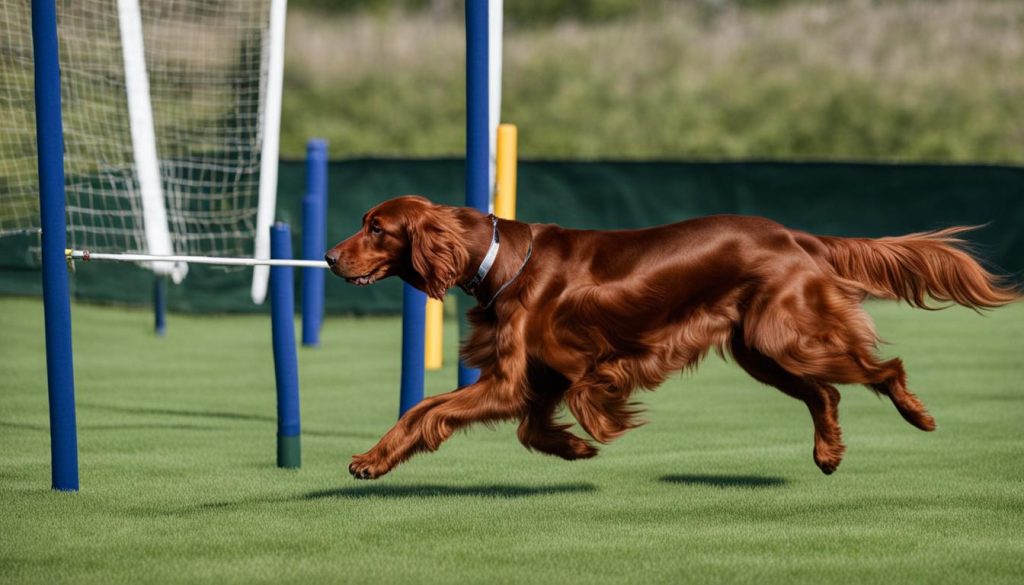Training an Irish Setter requires consistent effort and patience. These friendly and active companions can be mischievous and slow to mature, making training essential to avoid behavioral issues. By focusing on specific training techniques and addressing common misbehaviors, you can shape a well-behaved and obedient Irish Setter.
Irish Setter training encompasses various aspects, from obedience training to behavior modification. Whether you’re training a puppy or an adult dog, the following tips and techniques will help you establish a strong foundation of discipline and cooperation.
Irish Setter Training
- Consistency and patience are key when training an Irish Setter.
- Address common misbehaviors such as howling, barking, and separation anxiety through training.
- Focus on attention span training and managing prey drive for better control.
- Incorporate positive reinforcement techniques for effective training.
- Ensure your Irish Setter gets ample exercise to prevent destructive behavior.
Training Tips for Positive Reinforcement
When it comes to Irish Setter training, positive reinforcement is a highly effective technique. Unlike negative training methods that rely on punishment, positive reinforcement focuses on rewarding desired behaviors. This approach not only helps in obedience training but also strengthens the bond between you and your furry companion.
To effectively use positive reinforcement, you can utilize treats, praise, and affection as rewards. When your Irish Setter follows a command successfully or exhibits good behavior, immediately provide verbal praise and a tasty treat. This positive association encourages them to repeat the behavior in the future.
Teaching basic commands is a fundamental aspect of obedience training. With positive reinforcement, you can easily teach your Irish Setter to sit, come, and perform other basic commands. Here’s a simple guide to get started:
- Sit: Hold a treat above your Irish Setter’s head, and slowly move it backward while saying “sit.” When they lower their bottom to the ground, reward them with the treat and verbal praise. Repeat this process until they understand the command.
- Come: Begin by saying your Irish Setter’s name followed by the command “come.” When they approach you, reward them with the treat and praise. Gradually increase the distance between you and your dog to reinforce their understanding of the command.
- Stay: Start by having your Irish Setter sit or lie down. Hold your hand up and say “stay.” Take a step back, and if they remain in place, reward them with a treat and praise. Gradually increase the duration of the stay and the distance between you and your dog.
Remember, consistency is key when using positive reinforcement. Practice these commands daily in short training sessions to reinforce the behavior and build a strong foundation for further training.
Using positive reinforcement, you can effectively train your Irish Setter and nurture their obedience. By focusing on basic commands and incorporating rewards, you’ll establish a positive learning environment that will make Irish Setter training enjoyable for both you and your furry companion.
Exercise and Mental Stimulation
Proper exercise and mental stimulation are essential for the overall well-being of Irish Setters. These energetic and active dogs require at least one hour of exercise every day to stay fit and prevent destructive behavior. Engaging in physical activities such as going for long walks, playing fetch in the park, or participating in dog sports can meet their exercise needs and keep them physically challenged.
However, it’s not just physical exercise that Irish Setters need. Mental stimulation is equally as important for their mental and emotional health. These intelligent dogs thrive in environments that challenge their minds, and providing them with mental enrichment activities can prevent boredom and destructive behaviors.
One great way to combine exercise and mental stimulation is by enrolling your Irish Setter in training classes. Irish Setter training classes offer structured exercises and mental challenges that will keep your dog engaged and learning. Look for reputable Irish Setter training classes or programs that focus on obedience training and provide a positive learning environment.

In these classes, your dog will not only learn obedience commands but also have the opportunity to socialize with other dogs, improving their social skills and overall behavior. Additionally, Irish Setter training classes provide a consistent and structured approach to teaching your Irish Setter new skills and reinforcing good behavior.
Remember, exercise and mental stimulation go hand in hand when it comes to raising a happy and well-balanced Irish Setter. By providing them with regular physical activities, engaging their minds through mental challenges, and enrolling in training classes, you can ensure that your Irish Setter remains physically and mentally stimulated, leading to a happier and healthier canine companion.
Socialization and Behavior Modification
Socialization plays a crucial role in shaping the behavior of Irish Setters. By exposing them to various environments, people, and other pets from a young age, you can prevent fear and aggression from developing.
One effective method of socialization is to enroll your Irish Setter in puppy classes or obedience training programs. These classes provide structured social interactions and guidance from experienced trainers. They also offer an opportunity for your dog to learn and practice essential commands in a controlled setting.

Another vital aspect of training is leash training. Irish Setters are known to be energetic and spirited, which can result in excessive pulling during walks. Leash training can help you establish control and ensure both your dog’s safety and the enjoyment of your walks together.
When leash training, use positive reinforcement techniques to encourage your Irish Setter to walk calmly by your side. Reward them with treats and praise when they exhibit the desired behavior. Remember to be patient and consistent throughout the training process.
Crate training is also an effective tool for behavior modification, particularly in housebreaking your Irish Setter and providing them with a safe space. Introduce the crate gradually and associate it with positive experiences, such as meals and quiet time. A crate can serve as a den-like retreat for your dog, aiding in their overall behavior and reducing anxiety.
Remember, behavior modification takes time and dedication. Consistency in training methods is key to helping your Irish Setter develop good behavior and become a well-rounded companion.
Conclusion
Irish Setter training requires consistency, patience, and positive reinforcement. By focusing on basic commands, exercise, socialization, and behavior modification, you can shape obedient behavior and have a well-behaved companion.
When it comes to basic commands, remember to start with the essentials like sit, stay, and come. Use positive reinforcement, such as treats and praise, to reward your Irish Setter for correctly following these commands. Consistency and repetition are key to ensuring that your dog understands and responds to these commands consistently.
Exercise is crucial for keeping your Irish Setter physically and mentally stimulated. Aim for at least an hour of exercise per day, which can include activities like brisk walks, jogging, or playing fetch. This not only helps prevent destructive behavior but also promotes a healthy lifestyle for your furry friend.
Additionally, socialization and behavior modification are essential for a well-rounded Irish Setter. Introduce your dog to different environments, people, and other pets from a young age to prevent fear and aggression. Leash training and crate training can also be valuable tools in shaping positive behaviors and ensuring safety.
Always remember to tailor your training approach to the individual needs of your Irish Setter. Every dog is unique and may require different techniques and strategies. By prioritizing their physical and mental well-being throughout the training process, you can foster a strong bond and enjoy the rewarding experience of having a well-behaved and obedient Irish Setter by your side.
FAQ
How do I train an Irish Setter?
Training an Irish Setter requires consistency and patience. Use positive reinforcement techniques such as treats and praise to reward desired behavior. Start with basic commands like sit and come and gradually build up to more advanced obedience training.
What are some training tips for positive reinforcement?
Positive reinforcement is an effective training method for Irish Setters. Use treats and praise to reward good behavior and ignore or redirect unwanted behaviors. Teaching basic commands using positive reinforcement can help in obedience training.
How much exercise does an Irish Setter need?
Irish Setters require at least an hour of exercise per day to stay fit and prevent destructive behavior. Taking them for walks, playing fetch, or engaging in other physical activities can meet their exercise needs. Mental stimulation is also crucial for their well-being.
How can I socialize my Irish Setter?
Socialization is important for Irish Setters to develop good behavior. Introduce them to different environments, people, and other pets from a young age. Enrolling in training classes can provide structured exercise and opportunities for socialization.
Is crate training recommended for Irish Setters?
Yes, crate training can be a great complement to other training methods. It can be used as a tool for housebreaking and providing a safe space for the dog. Proper introduction and positive reinforcement can help your Irish Setter become comfortable with the crate.






